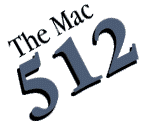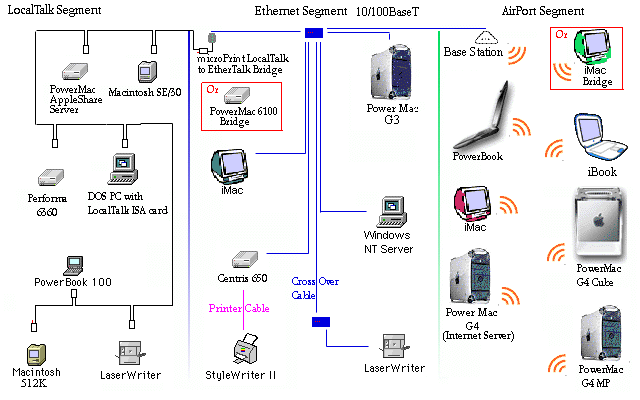
This page was archived in 2023 as part of the Mac Hut archive and is no longer updated.Most of the site pages were last updated around 2004 and some information may be out of date. Various links may be broken. Become a patron: Support our efforts by contributing a small amount each month to cover our hosting costs and the time it takes to archive these pages properly. Thank you. |

AppleTalk-ing - THE Macintosh networking resource since February 1998!
Connecting Macintoshes together is a dream that many Mac users have. The ability to play networkable games have been around since about 1985. Sharing files through a network is faster than - copying them to a disk, and bringing them over to another Mac and copying them again.
Networking Macs is easy. First of all...
What can you do with a network?
• Share hard drive space - Store files and applications on ONE Macintosh and have the others use it. Easy to backup.
• Play network games - If you have them available, why not?
• Share your printer. - Not everyone can afford 3 printers for 3 Macs. Share your printer among all of them.
• Share the Internet - One Internet account for several people, very economical if they are all Internet-aholics.
• Share other devices - This includes scanners, modems and external drives.
• Create an Intranet - an internal web site with information you need at a fingertip.
Why?
Because it is fun and probably your neighbors don't have one. Brag about it! :)
![]()
Building the Network-
• Lets build a simple 2 device LocalTalk network (Mac to Mac, Mac to a printer)
• Lets add a printer or another device to the LocalTalk network (Mac to Mac to Mac, Mac to Mac to a printer)
• Lets add in Ethernet (Mac to Mac to Mac, Mac to Mac to a printer, etc.)
• Extend your cables (When short cables are the only thing around & cable lengths)
• Lets add in AirPort (Wireless Mac to Mac communication!) The Mac 512 uses AirPort to update this web site.
- AirPort information
- How to setup the AirPort Base Station
- How to Administrator the AirPort Base Station
- How to setup the AirPort Software Base Station
• Networking Software (What the operating system needs to talk once the hardware is in place)
Important Components-
• File Server - An introduction to AppleShare and setting up your peer-to-peer network in System 7.x and up
• Bridges - Hook two different networks up - On the bottom of the Ethernet section
• Communication Server - When we explore this server, it will show how to dial in to a Mac network.
• Print Server - How to setup a global print queue for a Mac network.
• Internet/Intranet Server - When we explore this server, it will show how to setup your intranet/internet.
So You Wanna Build a Network... - This site goes into using a cable modem and a Linux box as an Internet gateway.
The fourth newsletter from The Mac 512 User Group discusses how to setup your old Mac on the Internet with System 7.
![]()
Here is a history lesson on Macintosh networking- The Macintosh Office - The first self-configuring LAN networking
• Includes the evolution of AppleTalk/LocalTalk?
![]()
Lets get down to business!
What goes into the making of a small AppleTalk network? Hardware, Software and patience
We will put together a network utilizing many pieces. Everything can see the resources that are applicable.

The above shows three segments EtherTalk (Ethernet), LocalTalk (PhoneNET), & AirPort speaking AppleTalk and TCP/IP.
What do you mean? - A quick lesson in the networking lingo.
Includes the different phases of AppleTalk!!
With the above picture example, we have three different cabling topologies - LocalTalk, EtherTalk (Ethernet) and AirPort.
The LocalTalk side we have 1 PowerMac running a dedicated file server (AppleShare) and 5 Macintoshes and 1 IBM PC clone. As they all talk the AppleTalk protocol they can see each other.
The Ethernet side we have a LocalTalk to Ethernet hardware bridge (microPrint) or a software bridge (PowerMac 6100), a PowerMac G3 B/W, original iMac, an IBM PC running Windows NT Server, a Centris 650 with shared StyleWriter II printer and a shared LaserWriter. The AppleShare server on the LocalTalk actually is the print server for this LaserWriter.
The AirPort side is running a AirPort Base Station or a Lime iMac running Software Base Station software, a PowerBook, an iBook, a Strawberry iMac, a PowerMac G4 Cube, a PowerMac G4 MultiProcessor and a PowerMac G4 running Internet server software.
** Don't forget any of the new Macintoshes can be part of the AirPort or Ethernet segments.
What is happening here?
The Power Mac G4 Cube can use the PowerMac AppleShare server (crossing over from AirPort to Ethernet to LocalTalk ).
The Macintosh 512K can access the Power Macintosh
The Strawberry iMac (on AirPort) or the Perform 6360 (on LocalTalk) can print to the LaserWriter (on Ethernet)
The PowerBook 100 can bring up any web pages from the Internet Server or through the Internet (crossing over from LocalTalk to Ethernet to AirPort).
The PowerMac G4 MultiProcessor tower (On AirPort) can use the Windows NT Server (on Ethernet).
Plus you can even have a Mac 512K use a Windows NT file server and a Windows PC use the AppleShare file server.
Conclusion!
Any client (Macintosh or IBM PC) can access any server. This means you can hook up the oldest Mac you have (except the original Macintosh 128K) to the newest PowerMacintosh and have them talk!
I am not endorsing Windows NT in any way. I am just stating with the flexibility of the Macintosh platform you can access other file servers than just Macintosh file servers.
![]()
What is the speed of the network?
LocalTalk - 230.K a second
EtherTalk - 10MB a second
Fast EtherTalk - 100MB a second
Gigabit EtherTalk - 1000MB a second
TokenTalk - 16MB or 4MB a second
Airport - 11MB a second
You best speed for the price is EtherTalk. Unless your Macintosh cannot run EtherTalk, then the best is LocalTalk. IF you can go wireless by all means do it! It is cool! TokenTalk is an outdated idea, too expensive. TokenTalk devices cost about 2/3s higher than EtherTalk.
[ The Mac 512 Site Map ]
[ System Showcase ] [AppleTalk-ing ] [ Mac Resources ] [ Help ]
Network Experience: gYounk is a Network+ Certified Professional (2002 edition which covers AppleTalk and wireless), Microsoft Certified Professional in Windows NT Server 4.0 (1999) & Windows 2000 Server (2001), and a Certified NetWare Administrator (1996) - using a Macintosh & PC mixed network since 1986, at work and at home.
The Mac 512 is a gYounk design & programmed site. Copyright 1998-2000 by gyounk.